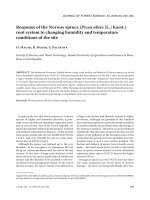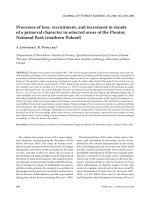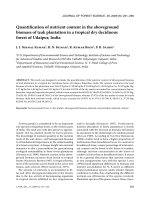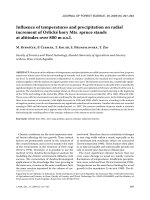Báo cáo lâm nghiệp: " Assessment of the contributions of glycolysis and the pentose phosphate pathway to glucose respiration in ectomycorrhizas and non-mycorrhizal roots of spruce (Picea abies L. Karsten)" docx
Bạn đang xem bản rút gọn của tài liệu. Xem và tải ngay bản đầy đủ của tài liệu tại đây (223.34 KB, 4 trang )
Assessment
of
the
contributions
of
glycolysis
and
the
pentose
phosphate
pathway
to
glucose
respiration
in
ectomycorrhizas
and
non-mycorrhizal
roots
of
spruce
(Picea
abies
L.
Karsten)
I. Bilger,
V.
Guillot,
F.
Martin
F.
Le
Tacon
Laboratoire
de
Microbiologie
Forestiere,
Centre
de
Recherches
Forestieres
de
Nancy,
Institut
National
de
la
Recherche
Agronomique,
Champenoux
54280
Seichamps,
France
Introduction
The
importance
of
carbon
supply
in
mycorrhizal
infection
and
symbiotic
activity
has
long
been
recognized.
The
supply
of
carbohydrates
by
the
higher
plant
to
the
fungus
is
a
very
basic
trait
of
mycorrhizal
symbiosis.
Mycorrhizal
plants
assimilate
more
photosynthates
than
non-mycorrhi-
zal
ones,
allocate
a
greater
fraction
of
the
assimilated
carbon
to
the
root
systems
and
lose
a
greater
fraction
of
the
assimi-
lated
carbon
to
respiratory
C0
2
than
do
non-mycorrhizal
plants
(for
a
review,
see
Martin
et
al.,
1987).
The
establishment
of
a
carbon
sink
by
the
ectomycorrhizal
hyphae
may
be
attained
by:
1 )
rapid
car-
bohydrate
degradation
for
respiration
and
for
energy
and
reducing
power
production
and
2)
conversion
of
plant
carbohydrates
into
fungal
biomass.
The
high
respiration
rate
of
fungal
tissues
has
been
pointed
out
by
several
authors
(France
and
Reid,
1983).
Most
studies
of
mycorrhizal
respi-
ration
deal
with
mitochondrial
respiration.
Much
less
is
known
about
the
oxidative
metabolism
of
glucose
in
mycorrhizal
roots.
The
substrate
used
as
well
as
the
pathways
potentially
involved
in
this
pro-
cess
are
not
known.
The
aim
of
this
study
was
to
determine
the
relative
contribution
of
glycolysis
and
the
pentose
phosphate
pathway
to
glu-
cose
oxidation
in
Norway
spruce
(Picea
abies)
ectomycorrhizas.
Materials
and
Methods
Plant
material
Four
year
old
plants
of
Picea
abies
L.
Karsten,
grown
on
a
sandy
soil,
were
sampled
from
a
commercial
bare-roots
nursery
(Merten,
Vosges,
eastern
France).
The
plants
were
removed
with
attached
soii,
stored
at
4°C
and
transferred
to
the
laboratory.
The
root
systems
were
washed
with
tap
water
and
all
soil
par-
ticles
were
removed.
The
pyramidally
branched
ectomycorrhizas
were
pale
brown,
racemose
with
a
prosenchymatous
sheath,
a
thin
mantle
and
an
extensive
Hartig
net
reaching
to
the
endodermis.
There
were
abundant
extramatric-
al
mycelia
(Hebeloma
sp.)
interconnected
with
loosely
woven,
pale
yellow
mycelial
cords
(see
Fig.
1
in
Al-Abras
et al
1988;
Dell
et al.,
1989).
Assuming
that
the
same
chitin/protein
ratio
occurs
in
the
mycelial
cords
of
Hebeloma
sp.
and
the
fungal
component
of
the
ectomycorrhi-
zas,
then
approximately
50%
of
the
protein
in
the
ectomycorrhizas
is
fungal
(Dell
et al.,
1989).
Radiorespirometry
A
radiorespirometry
study
was
performed
using
ectomycorrhizal
subsamples
and
the
non-
mycorrhizal
apices
of
exploratory
roots.
This
was
done
using
a
10
ml
continuous
!4C02-
evolving
and
-trapping
reaction
flask.
About
50
mg
of
fresh
tissue
were
incubated
in
5
ml
of
distilled
water
containing
10
nmol
of
[1-
14C]
glucose
or
11
nmol
of
[6-
14
C]glucose
for
90
min
at
22°C.
Experiments
were
started
by
the
ad-
dition
of
0.5
!Ci
(10.0
nmol)
of
suitably
labeled
[!4C]glucose.
An
airflow
of
200
ml-min-
1
was
maintained
and
14CO
2
was
collected
for
90
min.
Effluent
air
was
passed
directly
into
a
C0
2
-trap-
ping
scintillation
fluid
containing
an
organic
amine
(Carbomax,
Kontron)
in
10
ml
vials
and
counted
using
a
scintillation
counter
(Betamatic
I,
Kontron).
Residual
radiolabel
in
the
flask
was
determined
by
counting
aliquots.
Antibiotics
were
added
to
the
incubation
solution
at
the
following
concentrations
to
prevent
bacterial
activity:
0.02%
(w/v)
penicillin,
0.04%
(w/v)
streptomycin
and
0.008%
(w/v)
aureomycin.
Soluble
compounds
were
then
extracted
ac-
cording
to
A[-Abras
et
aL
(1988)
and
radio-
activity
determined
by
counting
100
ul
aliquots.
Chitin
was
determined
by
measuring
the
amount
of
fungal
glucosamine
resulting
from
acid
hydrolysis
of
chitin
in
mycorrhizal
roots
and
mycelial
cords
using
the
method
of
Vignon
et
al. (1986).
Statistical
analysis
Data
are
presented
as
means
of
4
or
6
repli-
cates.
Variance
analysis
or
mean
comparison
was
performed
on
the
logarithm
of
the
per-
centages
or
ratios.
Theoretical
The
approach
used
is
based
on
the
assumption
that
the
initial
yield
of
!4C02
from
[1-
14
C]glu-
cose
represented
glycolysis
and
the
pentose
phosphate
pathway,
whereas
that
from
[6-
14
C]glucose
represented
only
glycolysis
(Ap
Rees,
1980).
The
following
set
of
equations
enables
the
contribution
of
the
pentose
phos-
phate
pathway
(PPP)
to
be
calculated.
(1
-specific
yield
of
!4CO2
from
[6-!4Cjglucose)
Results
and
Discussion
The
radiorespirometric
method
was
applied
to
non-mycorrhizal
exploratory
roots
and
young
mycorrhizas.
Both
non-
mycorrhizal
roots
and
ectomycorrhizas
showed
virtual
simultaneous
emission
of
!4C02
from
[1-
1
4C]-
and
[6-!4C]glucose
with
similar
patterns
(data
not
shown).
These
data
indicated
the
operation
of
more
than
one
oxidative
pathway.
The
rapid
and
predominant
release
of
14CO
2
from
[1-1
4
C]glucose
coupled
with
low
emission
from
[6-!4C]glucose,
in
both
samples,
implied
both
a
minor
role of
the
tricarboxylic
acid
cycle
and
relatively
low
recycling
of
labeled
glucose
through
the
non-oxidative
part
of
the
pentose
phos-
phate
pathway
and/or
mannitol
cycle
(Martin
et al.,
1985).
Using
an
incubation
period
of
90
min
in
labeled
glucose,
the
C6/C1
ratios,
R,
and
R2
(Table
I),
were
found
to
range
from
0.10 to
0.13
for
mycorrhizal
roots and 0.30
to
0.43
for
non-mycorrhizal
ones.
The
low
C6/C1
ratios
of
the
mycorrhizal
roots
sug-
gests
a
high
activity
of
the
pentose
phos-
phate
pathway.
The
level
of
C0
2
released
from
[6-!4CJgl!ucose
was
always
compara-
tively
lower.
In
non-mycorrhizal
explorato-
ry
roots,
38%
of
the
carbohydrate
oxida-
tion
was
via
the
pentose
phosphate
pathway
and
62%
was
via
glycolysis.
On
the
other
hand,
50%
of
the
glucose
me-
tabolism
from
mycorrhizal
roots
was
cata-
lyzed
by
the
pentose
phosphate
pathway,
demonstrating
that
the
carbohydrate
oxi-
dative
pathways
are
drastically
altered
in
response
to
fungal
colonization
of
the
root.
To
determine
the
distribution
of
the
two
catabolic
pathways,
mycorrhizal
roots
were
further
separated
into
extramatrical
hyphae,
symbiotic
root
tissues
(mantle,
Hartig
net
hyphae
plus
root
cortex)
and
stele.
The
contribution
of
the
pentose
phosphate
pathway
was
different
in
the
various
mycorrhizal
tissues,
being
higher
in
symbiotic
tissues
(49.2%)
and
extrama-
trical
hyphae
(46.5%)
(Table
II).
The
contribution
of
the
pentose
phosphate
pathway
in
the
stele
of
mycorrhizal
roots
was
identical
to
that of
whole
non-mycor-
rhizal
roots
and
accounted
for
40%.
These
differences
between
mycorrhizas
and
non-mycorrhizal
roots
and
between
fungal
and
host
tissues
suggest
that
the
contribution
of
the
pentose
phosphate
pathway
to
respiration
is
higher
in
the
fun-
gal
component
than
in
the
plant
tissues.
The
fact
that
the
pentose
phosphate
path-
way
activity
was
even
higher
in
root
tis-
sues
colonized
by
the
fungal
cells
(mantle
and
Hartig
net)
than
in
extramatrical
hyphae
suggests
that
the
contribution
of
this
oxidative
pathway
is
stimulated
when
the
root
is
associated
with
a
symbiotic
fun-
gus.
This
increase
in
the
pentose
phos-
phate
pathway
activity
may
be
related
to
the
higher
metabolic
activity
of
the
Hartig
net
revealed
by
ultrastructural
studies
of
the
host-fungus
interface
(many
mito-
chondria
and
ribosomes,
extensive
devel-
opment
of
the
endoplasmic
reticulum,
lack
of
large
vacuoles)
(Kottke
and
Oberwink-
ler,
1986).
Whether
there
is
an
increase
in
the
ac-
tivity
of
the
pentose
phosphate
pathway
enzymes
or
changes
in
the
respective
polypeptide
amounts
during
ectomycorrhi-
za
formation
must
await
further
analysis.
References
Al-Abras
K.,
Bilger
I.,
Martin
F.,
Le
Tacon
F.
&
Lapeyrie
F.
(1988)
Morphological
and
physio-
logical
changes
in
ectomycorrhizas
of
spruce
[Picea
excelsa
(Lam.)
Link]
associated
with
ageing.
New Phytot
110,
535-540
Ap
Rees
T.
(1980)
Assessment
of
the
contribu-
tions
of
metabolic
pathways
to
plant
respiration.
In:
The
Biochemisfry
of
Plants, A
Comprehen-
sive
Treatise.
VoL
2
Metabolism
and
Respira-
tion.
(Stumpf
P.K.
&
Conn
E.E.,
eds.),
Academic
Press,
London,
pp.
1-27
Dell
B.,
Botton
B.,
Martin
F.
&
Le
Tacon
F.
(1989)
Glutamate
dehydrogenases
in
ectomy-
corrhizas
of
spruce
[Picea
excelsa
(Lam.)
Link]
and
beech
(Fagus
sylvatica
L.).
New
Phytol.
111, 683-692
France
R.C.
&
Reid
C.P.P.
(1983)
Interactions
of
nitrogen
and
carbon
in
the
physiology
of
ectomycorrhizae.
Can.
J.
Bot.
61,
964-984
Kottke
I.
&
Oberwinkler
F.
(1986)
The
cellular
structure
of
the
Hartig
net:
coenocytic
and
transfer
cell-like
organization.
Nord.
J.
Bot.
7,
85-95
Martin
F.,
Canet
D.
&
Marchal
J.P.
(1985)
!3C
nuclear
magnetic
resonance
study
of
mannitol
cycle
and
trehalose
synthesis
during
glucose
utilization
by
the
ectomycorrhizal
ascomycete
Cenococcum
graniforme.
Plant
Physiol.
77,
499-502
Martin
F.,
Ramstedt
M.
&
S6derhA[l
K.
(1987)
Carbon
and
nitrogen
metabolism
in
ectomycor-
rhizal
fungi
and
ectomycorrhizas.
Biochimie
69,
569-581
Vignon
C.,
Plassard
C.,
Mousain
D.
&
Salsac
L.
(1986)
Assay
of
fungal
chitin
and
estimation
of
mycorrhizal
infection.
PhysioL
V6g.
24,
201-207









